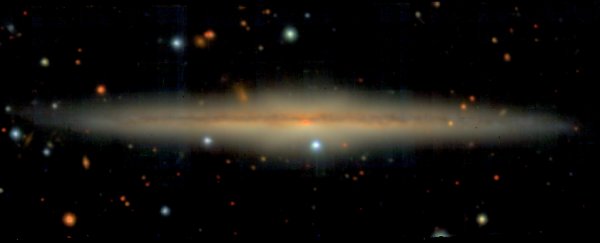Ever since the Gaia satellite began mapping the Milky Way in three dimensions with the highest precision yet, we've been learning a lot about our home galaxy's violent past.
The scrappy cannibal has collided with, and subsumed, multiple other galaxies over its 13.6-billion year lifespan. The largest of these, the Gaia-Enceladus dwarf galaxy (AKA the Gaia Sausage), took place around 10 billion years ago, and was thought to be responsible for a curious feature of the Milky Way's structure called the thick disk.
Now, however, it appears that this may not be the case. Astronomers have studied another galaxy with a thick disk, and determined that its evolution wasn't a cataclysmic accident, but just a pretty normal way for spiral galaxies to grow.
"Our observations indicate that the Milky Way's thin and thick disks didn't come about because of a gigantic mash-up, but a sort-of 'default' path of galaxy formation and evolution," said astronomer Nicholas Scott of the ARC Centre of Excellence for All Sky Astrophysics in 3 Dimensions (ASTRO 3D) and the University of Sydney in Australia.
"From these results we think galaxies with the Milky Way's particular structures and properties could be described as the 'normal' ones."
It's easiest to understand the thick and thin disks if you think of the Milky Way a bit like a burger. The thin disc, which is about 400 light-years thick and contains gas, dust and stars, is analogous to the burger patty; the thick disc, which extends to 1,000 light-years and contains only stars, is like the burger bun.
The thin disk is where you can find all the younger stars, richer in metals, although it contains stars of all ages. The thick disk is more sparsely populated, and contains only stars older than about 10 billion years.
This feature is only seen in some spiral galaxies, and astronomers don't really know how they got there, but based on Gaia data, a team of astronomers thought they had figured it out. They traced the motions of clusters of stars in the Milky Way's halo, and their chemical compositions, and found they had originated outside the galaxy. Modelling then suggested that the galactic merger that delivered these stars to the Milky Way also heated the pre-existing thin disk, inflating it into a thicker one.
Although we have seen other spiral galaxies with thick disks, it had been impossible to tell if these structures had the same star distribution as the Milky Way. Enter a spiral galaxy called UGC 10738, located 320 million light-years away.
You can tell roughly how old a star is based on its chemical composition. Younger stars have more metals in them than older ones, since these elements didn't exist in the galaxy until a generation or two of stars came along to produce them via the nuclear fusion of lighter elements.
The chemical compositions of stars can also be read in their light spectrum - some wavelengths are brighter or dimmer, depending on which elements are present.
Individual stars can't really be studied in distant galaxies; they're too far away to resolve with our current technological capabilities. What we can do is study the light coming from different regions, and ascertain what types of stars are in those regions as a population.
This is what makes UGC 10738 such a brilliant laboratory for studying a thick disk. Its edge is facing us, giving us a very clean, clear view of the thin and thick disk structures - we can actually make out the burger and the bun, and separate the light from each section. This is what Scott's team did, using the European Southern Observatory's powerful Very Large Telescope in Chile.
"Using an instrument called the multi-unit spectroscopic explorer, or MUSE, we were able to assess the metal ratios of the stars in its thick and thin discs," said astronomer Jesse van de Sande of ASTRO 3D and the University of Sydney.
"They were pretty much the same as those in the Milky Way - ancient stars in the thick disc, younger stars in the thin one. We're looking at some other galaxies to make sure, but that's pretty strong evidence that the two galaxies evolved in the same way."
This doesn't mean that the Milky Way hasn't engaged in a bit of a fight with other galaxies, and it certainly doesn't mean the Gaia Sausage merger never took place (there's plenty of other evidence for that encounter). But it does seem to suggest that the Gaia Sausage wasn't responsible for puffing up the thick disk.
"It was thought that the Milky Way's thin and thick disks formed after a rare violent merger, and so probably wouldn't be found in other spiral galaxies," Scott said.
"Our research shows that's probably wrong, and it evolved 'naturally' without catastrophic interventions. This means Milky Way-type galaxies are probably very common. It also means we can use existing very detailed observations of the Milky Way as tools to better analyze much more distant galaxies which, for obvious reasons, we can't see as well."
While that puts us back a little ways in determining what did puff up the Milky Way's thick disk, it brings us forward in our study of thick disks and the evolution of spiral galaxies as a whole.
Now that the team has demonstrated that it's possible to spatially resolve chemical distributions of other galaxies, they plan to apply their techniques to a statistically significant sample of similar galaxies to see how well their findings hold up.
The research has been published in The Astrophysical Journal Letters.
